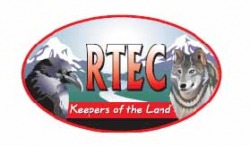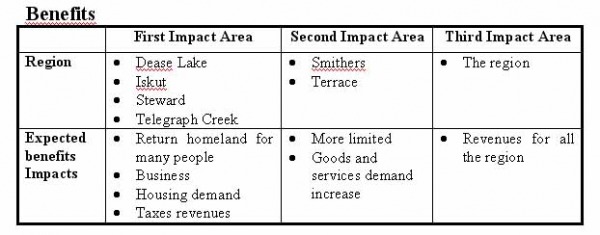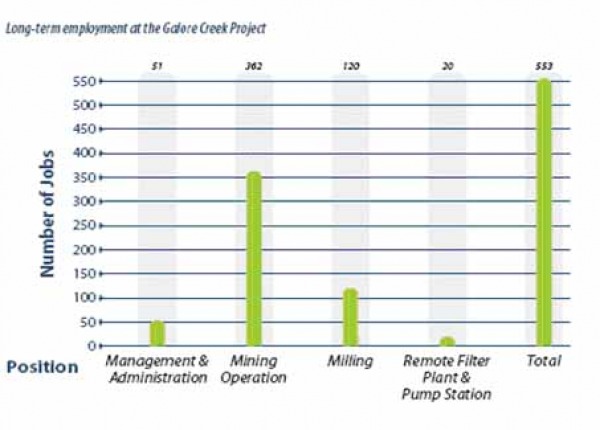Socio-economic impacts

· First Nations
· Benefits
· Loss
· Employment
First Nations – The Tahltans
Tahltans is the only first nations that claimed the Galore Creek territory. They are Athapaskan-speaking people of Dene descent. Their territory expands over 93,000 km2 of land. It starts from the drainage basin of the Stikine River and its tributaries to Dease Lake, the Iskut, Cottonwood and upper Racheria rivers and the northern sources of the Nass and Skeena rivers. They are two third of the population of Galore Creek region. Tahltan are represented through three comities the Tahltan Central Council, the Tahltan Band and the Iskut Band. In order to represent their interest in front of the Galore Creek Mining Corp., Tahltans chose the Tahltan Central Council. Tahltan Central Council has an advantage over the rest because it is consulted by provincial and federal government agencies for permitting stage. Also, the council is member of the Northwest Mine development Review Committee based in Smithers. The Ministry of Energy, Mines and Petroleum Resources chaired on this Committee. So, the biggest advantage of the committee is power over on permit applications and review or comment the Mines Act. The Iskut Band Council had the objective to encourage the public participation with 30,000$.
Tahtlan history is closely linked with mining extractions. They were employed in Obsidian, Gold, Coal, Cassiar, Golden Bear and Eskay Creek. Iskut Indian reserve #6 is the main quarter of Iskut First Nation. Dease Lake #9 Reserve is the main quarter of Tahltan. It is at 280 km from the Project site.
History Timeline

Fall 2003: Proponents presentation of the company and the project
May 2004: Formation of Rescan Tahltan Environmental Consultants (RTEC)
· Special formation between RTEC and the Tahltan Nation
June 2004:
October 2004: Proponent in predominately Tahltan communities
May/June 2005: In Dease Lake, Iskut and Telegraph Creek
October 2005:
February 10, 2006: A comprehensive agreement was reach.
June 13-15, 2006: Proponent participated in the Tahltan Resource Development Forum in Telegraph Creek, Dease Lake and Iskut.
Tahltan Heritage Resource and Environmental Assessment Team resulted in the creation of a document including all detailed concerns and questions of the Tahltan community (Annexe E).
Main concern expressed by the Tahltan Heritage Resource and Environmental Assessment Team were:
1. Protection of archaeological and heritage of the Talhtan
2. Water quality
3. Reverse adverse social effects
4. Negotiated the respect of their traditions
1. Protection of archaeological and heritage of the Tahltan

No archaeological artefacts were found during the two years of search in 2004 and 2005. It is true that NovaGold did not evaluate the entire map established by the Traditional Knowledge. NovaGold established further archaeological researches in area not implicated in direct land destructions. The company did recognize the possible destruction of Tahltan community.
Mitigation
Compensations were not discussed in this report. However, it was already mentioned that Tahltan Heritage Resource will receive compensations to preserve cultures and history preserved. Also, a protocol will be created in order to all employees to know how to react in the accidental discovery of a potential archaeological site.
2. Water quality
Tahltan community addressed great concerns about water quality following post-closure of the mine. Their concerns were answered with the EIA documentation. Therefore, the description of water quality is the reference for this subsection.
3. Reverse adverse social effects
The incomes of new jobs are not always only a benefit for closer communities in the North. New moneys and jobs away from the home ring also indesirable behavious. A described complete list was mentioned in the EIA report.
Among them there was:
· Increase in violence
· Increase in dependence
· Loss in family structure and family support
· Increase in stress and stress-related illness
· Unplanned pregnancies and sexually transmitted disease
· Health and social services under constant pressure due to the previous points
· Potential contamination of water sources foods and medicines (see water quality section)
· Loss of their language due to massive immigration
· Reduce High school and post-secondary education graduates
This entire list is known as a domino effect. It might result in the lost of traditional practices of Tahltan Heritage or simply destroy the spirit community. Problems within a society affect future generation as well. The Tahltan do not wish to see their society fall due to a lack of implication. They will require massive investments from the Galore Creek Mining Corp. to help them provide help when needed. The proponents included career sessions and long-term training in their commitments.
Mitigation

Compensations were calculated to develop programs to help the development of the community. The compensations were set for 1$ million each year or 0.5 to 1% of NSR Royalty each year. Those numbers were accepted and Tahltan sign the agreement on February 10, 2006
4. Negotiated the respect of their traditions
Tahltan Central Council negotiated with the proponents in order to maintain traditions. Summer represents the months of fishing and family reunions. Fall and winter are seasons for hunting to acquire meat provision. In order to limited massive immigration and to sustain the villages of the region, the priority was set to focus employment in the Tahltan community.
Mitigation
High proportion of Tahltan might be employed in the mine, but that also mean less villagers at home. Proponents agreed to include the right for all members of Tahltan community to participate to their traditional activities. They will also have day-off in special autochthones meetings and funerals. Those methods will prevent the collapse of their traditions.
First Nations – TraditionalKnowledge
Tahltan Traditional Knowledge included:
· Trapline holders
· Big game outfitters
· Hunters
· Prospectors
· Matriachs of high-ranking families
· Researchers from the Tahltan 1983-1985 land use and occupancy study
Traditional Knowledge brought information to the Proponent during summer 2005. Thirty-two persons were identified as helper for the traditional knowledge. This consultation leaded to the selection of the access route. They also provided a described map of ancestral traditional map with location of hunting camps. Traditional knowledge was also useful to identify the season flow and precipitation of the surrounded area. In addition, the Proponents wished to continue correspondence with the Tahtlan Council. Also, further meetings should be plan to develop a monitoring programs using both Traditional Knowledge and science.
Mitigation
The proponents assure that money will be given to Tahtlan community to reduce the effects.
Employment
The region worked in different areas. At least, 98 Tahltans were employed at the Eskay Creek mine that closed in 2007.
Other economic activities were:
o Mining (many projects, most closed recently)
o Forest (not developed activity, but the license obtained)
o Guiding and Outfitting (Two official guide)
o Trapping (only 3 traps are active on 7 existing)
o Recreation Tourism
Compensations should be provided for trapping and the guiding and outfitting. Recreation tourism is another reserve more downstream of Iskut-Stikine River. Forestry is not developed yet even if there is a high capacity with an annual cut of 120,000 m3. There is little chance that the mining project impact on it.

Construction phase
Construction phase will provide almost 1,000 jobs. Pre-construction phase has been achieved which mean the recruitment and mobilization is done. 1,000 jobs is an important amount of new jobs available. Of course, the Proponents express the desire to employ as many Tahltans and local villagers as possible in order to decrease unemployment in the region. However, it is clearly started in the EIA document that they would not be enough employees available and capable to meet the requirements. Therefore, the region might receive workers and their families. This immigration will put pressure of the community that do not have the resources to provide housing, health services and social services required. Talhtan cultures might be under a greater pressure, but the community will receive money to mitigate direct impacts of external employment.
Employment at the Galore Creek mining project comes with a formation on security at work and formation for the jobs. Nothing was found for formation or seminar on prevention of sexual aggressions on work. Proponents have include the long-term training formation and career orientation in its commitments to the community in order to allow workers of the region to occupy high hierarchically jobs on the mine. Some social advantages will be given to the employees. Free bus will live villages to promote living in the village. Tahltan will conserve their rights to attempt their traditional activities without penalty. Housing is provided for workers with a cafeteria-style and other facilities (see infrastructure). Documentation did not provide any information on salary, health plan assurance or any others social advantages. The construction phase will require people for the construction of the infrastructure.
Operational phase
The operational phase should provide 553 jobs in diverse areas:
· 51 Management & Administration
· 362 Mining Operating
· 120 Milling
· 20 Remote Filter Plant & Pump Station
Total jobs: 553
Proponents submitted in the Annual Information form for the year ended in November 20 2007, numbers of how many economic benefits related to employment taxes. The government revenues include corporate income taxes, goods and services and provincial taxes. Taxes should provide $26 million each year divided by two. Federal revenues would be $13 million and provincial would be the same amount. The property taxes only should brought $1,5 million in addition to normal revenues. Workers spend the money in industrial good and services so related industries should make $173 additional revenues. Therefore, the contribution to the Gross domestic product should be of $72 million.
Goods and services
Employment should not be restricted to the Galore Creek mining project. Good and services might not even be installed in the region. Therefore, it is planned that the supplier industries will also contribute to an increase in jobs opportunities. Some suppliers are already installed in the region because it was providing previous mining project. The workers should bring $30 million in output and $6 million to the Gross domestic product. This increase of money in the region should required supplier industries to engage 265 employees.
Residual Impacts
When the mine will close, the employees will be out of work. The proponent promised to train and encourage formation to mitigate this effect.
WRITTEN BY: ANDRÉE-ANNE ROULEAU
LAST UPDATED: Sunday, April 13th, 2008.
References:
NRSC 437 Lecture notes
http://www.eao.gov.bc.ca/epic/output/html/deploy/epic_document_239_23630.html









